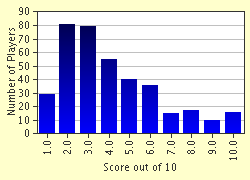Quiz Answer Key and Fun Facts
1. At the time of the discovery's announcement the dwarf planet had no name because the discoverers wanted to officially announce it when they formally proposed it to the International Astronomical Union. It had a "working title" though. Which one?
2. Nothing is ever left unnamed for long in science. What was the official yet uninspiring designation of the new dwarf planet?
3. Why had Eris not been discovered prior to 2003?
4. In many ways the new dwarf planet is like Pluto: its orbit is highly elliptical and tilted to the ecliptic plane (unlike the other eight planets, which have more or less circular orbits and lie neatly in the ecliptic plane). What is the angle between the ecliptic plane and the orbit of this dwarf planet (the orbital inclination)?
5. Information about the new dwarf planet was obviously scarce and few things were certain. The orbit, however, seemed to be totally determined. How far away from the sun was it thought to be at the time of discovery?
6. Give or take 1%, how long does it take the new dwarf planet to travel around its elliptical path around the sun once. In other words, how long is its year?
7. At the time of discovery, how big was this new dwarf planet assessed to be?
8. Maybe you are intrigued now and want to see the new dwarf planet for yourself. What do you need?
9. When was the last time an object more than twice the size of Eris was discovered in our Solar System?
10. At the time of its discovery, Eris was described by NASA as 'the tenth planet'.
Source: Author
triviapaul
This quiz was reviewed by FunTrivia editor
crisw before going online.
Any errors found in FunTrivia content are routinely corrected through our feedback system.

